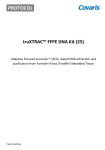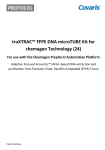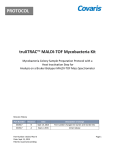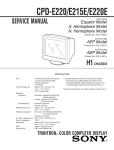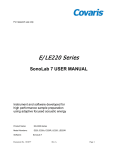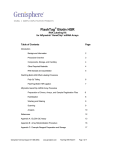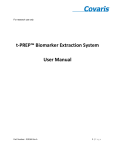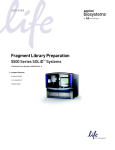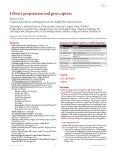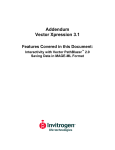Download truXTRAC FFPE RNA Kit
Transcript
PROTOCOL truXTRAC™ FFPE RNA Kit (25) Adaptive Focused Acoustics™ (AFA) -based RNA extraction and purification from Formalin-Fixed, Paraffin-Embedded Tissue Contents INTENDED USE ....................................................................................................... 2 INTRODUCTION ...................................................................................................... 2 REVISION HISTORY .................................................................................................. 3 KIT CONTENTS ....................................................................................................... 3 STORAGE .............................................................................................................. 3 SUPPLIED BY USERS................................................................................................. 4 1 - PREPARATION ................................................................................................... 5 FFPE Tissue Sample ........................................................................................ 5 Buffers............................................................................................................ 6 Instruments .................................................................................................... 6 2 - RNA EXTRACTION FROM FFPE TISSUE .................................................................... 8 3 - RNA PURIFICATION.......................................................................................... 11 APPENDIX A – PARAFFIN EMULSIFICATION WITH AFA ENERGY ........................................ 12 APPENDIX B – TROUBLESHOOTING GUIDE .................................................................. 13 Part Number: 010268 RevE September 2015 Patents Granted and Pending 1|P a g e INTENDED USE The truXTRAC FFPE RNA Kit is intended for use in molecular biology research applications. This product is not intended for the diagnosis, prevention, or treatment of a disease. INTRODUCTION The truXTRAC FFPE RNA Kit is designed for the controlled and efficient extraction of RNA from Formalin Fixed, Paraffin Embedded (FFPE) tissue samples with the Covaris Adaptive Focused Acoustics (AFA™). AFA enables the active removal of paraffin from FFPE tissue samples in aqueous buffer, allowing simultaneous tissue rehydration. Compared to traditional passive, chemical-based methods of paraffin removal, this mechanical process is not as limited by the thickness of FFPE tissue sections. The AFA process enables the use of thicker sections, which can increase RNA yield and minimize the impact of increased RNA degradation at the exposed surfaces of a section. The truXTRAC process results in high yields of high-quality RNA well suited for analytical methods such as next-generation sequencing or qPCR. This protocol is optimized for sections up to 25 µm in thickness. Important Notes on FFPE Samples: The yield of RNA from FFPE tissue blocks is highly variable. Factors such as fixation time, size and thickness of the sections, the ratio of tissue to wax, the type of tissue, and the age of the FFPE block are the main causes for this variability. The quality of RNA isolated from FFPE samples is also highly variable. During the fixation process, RNA is cross-linked to proteins and other nucleic acid molecules to varying degrees. Incomplete reversal of this crosslinking may cause the isolated RNA to perform less well in downstream applications such as PCR and qPCR. In addition, the size of RNA fragments isolated from FFPE samples is generally smaller than that of RNA isolated from fresh or frozen tissues. This is particularly evident in older FFPE sample blocks or sample blocks stored at elevated temperatures. Note for first time users: Given the highly variable yield of RNA from FFPE tissue blocks, we recommend using FFPE blocks that have been well characterized for yield and quality for initial testing of the truXTRAC FFPE kit. Ideally, samples should be extracted immediately after sectioning. Part Number: 010268 RevE September 2015 Patents Granted and Pending 2|P a g e REVISION HISTORY Part Number Revision Date Description of change 010268 A 11/14 Initial release 010268 B 3/15 Updated M220 Holder requirement 010268 C 5/15 Changed name of Heat Block microTUBE Adapter 010268 D 7/15 Sample input requirements clarified 09/15 Changed incubation time to reverse formaldehyde crosslinks to 1 hour 010268 E KIT CONTENTS RNA Lysis B1 Buffer RNA Wash RNA Elution PK Solution DNase I (Lyophilized) DNase Buffer MnCl2 Solution RNA Purification Columns RNA Collection Tubes RNA Elution Tubes microTUBE-130 AFA Fiber Pre-Slit Screw-Cap 3 ml 7.5 ml 11 ml 3 ml 300 µl 1 Vial 220 µl 400 µl 25 25 25 25 SDS INFORMATION IS AVAILABLE AT http://covarisinc.com/resources/safety-data-sheets/ STORAGE This kit should be stored at room temperature (18 – 25 °C). The reconstituted DNase I should be stored at (–20°C). Part Number: 010268 RevE September 2015 Patents Granted and Pending 3|P a g e SUPPLIED BY USERS Covaris Instruments and Parts Required parts Focusedultrasonicator Rack/ Holder/ Insert Accessories E220 M220 S-Series evolution Rack E220e 4 Holder XTU Rack 24 Place Rack-XT 24 Place PN500414 & microTUBE Holder Place microTUBE Insert XTU Screw-Cap (PN microTUBE microTUBE Screw Cap PN500489 500308) and Screw-Cap Screw-Cap (PN500432) or Holder-XT Intensifier (PN500339) (PN500388) and Intensifier PN500358 (*) (PN500141) (PN500141) Centrifuge and Heat Block microTUBE Adapter (PN500406) LE220 E220 & E210 Optional parts Accessories FFPE tissuePICK (PN520163) FFPE sectionPICK (PN520149) FFPE sectionWARMER (PN500403) (*) This holder has been discontinued Other supplies: • Microcentrifuge with 16,000 x g capability • Dry heating block such as Eppendorf ThermoMixer or similar with either 1.5 or 2 mL heat block inserts. We recommend two heating blocks, preset at 56°C and 80°C respectively. • Ethanol (>96%), MB Grade e.g., Thermo Scientific (PN BP2818-100). • 1.5 mL nonstick nuclease free microfuge tubes e.g., Life Technologies (PN AM12450). • Nuclease Free water, e.g., Life technologies (PN AM9932) or equivalent. Part Number: 010268 RevE September 2015 Patents Granted and Pending 4|P a g e 1 - PREPARATION FFPE Tissue Sample 1. Sample Input requirements The truXTRAC process is highly efficient at removing paraffin even from relatively thick FFPE sections while simultaneously rehydrating the tissue. Use of thicker sections is often desirable, both for increased yield and since DNA or RNA in the exposed surfaces of a section tends to degrade quickly. We recommend using sections between 15 and 25 µm thick. NOTE: Excess paraffin will adversely affect the yield and quality of DNA and RNA extracted from FFPE. We strongly advise trimming off any excess of paraffin before sectioning a FFPE tissue block, or after the section has been cut from the FFPE block. A ratio of 80% tissue to 20% paraffin or higher is ideal. Size (thickness or diameter) FFPE Sections FFPE Sections Mounted on slide “scrolls” or “curls” 4 to 10 µm Size (length) 7 to 10 µm 7 to 15 µm NA 16 to 25 µm <10 mm (A) Collection tool tissuePICK (B) sectionPICK (B) Maximum number of samples Per Tube* 2x tissuePICK (200 mm2 tissue for a 5 µm section) 2x sectionPICK NA 2 1 * Numbers represent trimmed sections only NOTES A. If the FFPE sample is longer than about 10 mm, cut it in half before loading. B. For optimal tissuePICK and sectionPICK performance, tissue sections should be mounted on uncoated slides. The tissuePICK and sectionPICK should always be used in conjunction with a sectionWARMER. Part Number: 010268 RevE September 2015 Patents Granted and Pending 5|P a g e WARNING: The total mass of FFPE sample processed per extraction should be between 2 to 5 mg. Lower amounts may result in insufficient yield and higher amounts may cause spin columns to become partially or fully clogged. 2. Tissue Fixation Requirements The yield and quality of RNA extracted from FFPE tissue blocks is highly dependent on tissue collection and paraffin embedding procedures. For good yields of high quality RNA: - Use a maximum fixation time of 24 hours Use Formalin solution, neutral buffered, 4% Fix sample tissue sample as quickly as possible after collection Buffers 1. Add 275 µL of Nuclease Free water to DNase I bottle. Mix by inverting bottle until pellet is completely dissolved. Do not vortex. We recommend storing the rehydrated DNase into aliquots using sterile, RNase-free microcentrifuge tubes Store reconstituted DNase I at –20°C. 2. Add ethanol to RNA Wash: Add 25 ml EtOH to 11 ml RNA Wash buffer before use. 3. Check Buffer B1 and RNA Lysis Buffer: A white precipitate may form during storage. Incubate the bottles at 50 – 70 °C before use to dissolve any precipitate. Instruments NOTE: For detailed instructions on how to prepare your particular instrument please refer to your instruments User Manual. 1. For S, E and LE-Series Focused-ultrasonicators, fill the water bath, set the chiller temperature as described in Table 1 and allow the system temperature to equilibrate and the water bath to degas. - E220 evolution: Load the plate definition “500432 Rack E220e 4 Place microTUBE Screw Cap” and check that the intensifier is in place. - E210 or E220: Load the plate definition “500308 Rack 24 Place microTUBE Screw-Cap” and check that the intensifier is in place. - LE-Series, load the plate definition “500388 Rack-XT 24 Place microTUBE Screw-Cap”. NOTE: If you do not see a plate definition on your system, please contact Covaris technical support at [email protected]. Part Number: 010268 RevE September 2015 Patents Granted and Pending 6|P a g e Table 1 - Focused-ultrasonicator setup Instrument S-Series E-Series & L-Series Water level (Fill/RUN scale) Chiller temperature 15 10 18°C 18°C 2. For M-Series Focused-ultrasonicators, put the Holder XTU and the Insert XTU microTUBE 130 µl (or Holder-XT microTUBE) in place and fill the water bath until the water reaches the top of the holder. Allow system to reach temperature (20°C). 3. Insert the required number of Heat Block microTUBE Adapters into two heat blocks and heat them to 56 and 80°C. Part Number: 010268 RevE September 2015 Patents Granted and Pending 7|P a g e 2 - RNA EXTRACTION FROM FFPE TISSUE 1. Open microTUBE Screw-Cap, add 110 µl RNA Lysis Buffer into microTUBE and load FFPE tissue. Affix Screw-Cap back in place. NOTE: if the FFPE tissue samples are loose or broken the samples may be added to the microTUBE prior to RNA Lysis Buffer addition to facilitate easier loading. 2. Process the samples using the settings provided in Table 2 below to dissociate the paraffin and rehydrate the tissue. (Please see the example in Appendix A.) During the AFA process it is normal for the solution to turn milky white as the paraffin is emulsified. Table 2 - Paraffin removal and tissue rehydration settings Duty Peak Incident Cycles per Treatment Temperature System Factor Power burst Time (Instrument) S220 or E220 10% 175 Watts 200 300 sec 20 °C S2 or E210 10% 5 (Intensity) 200 300 sec 20 °C M220 20% 75 Watts 200 300 sec 20 °C LE220(1) 15% 450 Watts 200 300 sec 20 °C (1) As Covaris LE220 process multiple samples at a time, its PIP is distributed across microTUBEs, and power received by individual microTUBEs stays within the 200 W limit. 3. Open Screw-Cap microTUBE, add 10 µl of PK solution to the sample and affix Screw-Cap back in place. 4. Process the sample using the settings provided in Table 3 below to properly mix Proteinase K with the sample. Table 3 – Proteinase K mixing settings Duty Peak Incident Cycles per Treatment Temperature System Factor Power burst Time (Instrument) S220 or E220 10% 175 Watts 200 10 sec 20 °C S2 or E210 10% 5 (Intensity) 200 10 sec 20 °C M220 20% 75 Watts 200 10 sec 20 °C (1) LE220 30% 450 Watts 200 10 sec 20 °C Part Number: 010268 RevE September 2015 Patents Granted and Pending 8|P a g e 5. Proteinase K digestion: a. Insert the required number of Centrifuge and Heat Block microTUBE Screw-Cap Adapters into a Heat Block. b. Load the microTUBEs into the adapters and incubate for 15 minutes at 56°C. NOTE: Some tissue types, such as fibrous or muscle tissues, may require longer lysis incubations to maximize RNA recovery (i.e., 2 hours to overnight). Incubation time for these types of tissues should be determined empirically or contact Covaris Application Support. 6. Reverse formaldehyde crosslinks: a. Insert the required number of Centrifuge and Heat Block microTUBE Screw-Cap Adapters into a Heat block. b. Load the microTUBEs into the adapters and incubate for 1 hour at 80°C NOTE: If you are using the same heat block for both the 56°C & 80°C incubations, the microTUBE should be stored at room temperature until the heat block reaches 80°C 7. Transfer the sample to a clean 1.5 ml microcentrifuge tube and centrifuge at 15,000 x g for 15 minutes. 8. Transfer the supernatant to a new microcentrifuge tube taking care to leave the pellet and residual wax behind. Small amounts of residual wax will not interfere with the RNA purification). 9. Skip to Section 3 – RNA Purification if DNase I treatment is not required. 10. DNase I treatment (Optional): The sample can be treated with DNase I to remove residual DNA before RNA purification. Prepare the DNase master mix as shown below. Component Volume Per Sample (in µl) MnCl2 Solution 13 DNase Buffer 7 DNase I 10 Total Volume per sample; 30 µl NOTES – DNase I usage: - Prepare only the amount of DNase master mix required - Thaw and keep the DNase I enzyme on ice during use - The DNase I enzyme is sensitive to physical inactivation. Mix by gentle pipetting. Do not vortex. - Prepare the DNase treatment mix immediately before use. The components of the DNase master mix should be stored separately and mixed fresh for each set of RNA extractions. Part Number: 010268 RevE September 2015 Patents Granted and Pending 9|P a g e 11. Add 30 μl of freshly prepared DNase master mix to each sample and mix by pipetting gently. 12. Incubate for 15 minutes at room temperature (20–25°C) 13. Proceed to Section 3 immediately – RNA Purification. Part Number: 010268 RevE September 2015 Patents Granted and Pending 10 | P a g e 3 - RNA PURIFICATION 1. If DNase I treatment was not conducted add 30 µl of nuclease free water to each sample. 2. Add 175 µl Buffer B1 to your samples and vortex to mix. 3. Add 200 µl ethanol (>96%) to samples and vortex to mix. 4. Insert RNA Purification Columns into provided RNA Collection Tubes. 5. Transfer the samples to the RNA Purification Columns. Note: Small amounts of residual wax will not interfere with the RNA purification). 6. Spin the assemblies (RNA Purification columns/collection tubes) at 14,000 x g for 1 minute. NOTE: If all the sample did not pass through the column, please add an additional 5 minutes spin at 14,000 x g 7. Discard the flow-through and place the RNA Purification Column back in the Collection Tube. 8. 1st wash: Add 500 µl RNA Wash. Spin the assemblies at 14,000 x g for 1 minute. 9. Discard the flow-through and place the Purification Columns back in the Collection Tubes. 10. 2nd wash: Add 500 µl RNA Wash. Spin the assemblies at 14,000 x g for 1 minute. 11. Discard the flow-through and place the RNA Purification Columns in the RNA Collection Tubes. 12. Dry RNA Purification Column: Spin the assemblies at 14,000 x g for 2 minutes. 13. Elute RNA: RNA elution is performed in two steps: Step 1: Place the RNA Purification Columns into a RNA Elution Tubes and add 20 to 50 µl RNA Elution Buffer to the center of the column. Spin the assemblies at 200 x g for 2 minutes. Step 2: Without removing the assemblies from the centrifuge spin at 14,000 x g for an additional 1 minute. 14. Remove assemblies from the centrifuge, discard RNA Purification Columns and keep the eluted RNA on ice for further analysis. RNA should be kept at -80C for long term storage. NOTE: RNA Elution buffer composition is Nuclease Free Water Part Number: 010268 RevE September 2015 Patents Granted and Pending 11 | P a g e APPENDIX A – PARAFFIN EMULSIFICATION WITH AFA ENERGY Paraffin is emulsified in microTUBE Screw-Cap using a Covaris S220 Focused-ultrasonicator. Sample before (left side) and after (right side) processing. Sample was a 10 μm kidney tissue section. Additional Notes 1. Best Practices to determining the yield and purity of isolated RNA: • • To determine RNA yield with the highest level of accuracy, a fluorometric assay such as the Qubit TM (Life Technologies) should be used. In addition, spectrophotometric analysis of RNA for A260/280 and A260/230 ratios will determine if protein or peptide contamination is present in the sample. 2. See following link: http://covarisinc.com/wp-content/uploads/pn_010268.pdf for updates to this document. 3. The treatment settings listed in this document are recommended guidelines. Actual results may vary depending on the tissue type, mass, and previous handling of FFPE samples. Part Number: 010268 RevE September 2015 Patents Granted and Pending 12 | P a g e APPENDIX B – TROUBLESHOOTING GUIDE Issue Solution Comments / Suggestions Low tissue to wax ratio in FFPE section. We strongly advise trimming off any excess of paraffin before sectioning a FFPE tissue block, or after the section has been cut from the FFPE block. A ratio of 80% tissue to 20% paraffin or higher is ideal. Excess paraffin will adversely affect the yield and quality of DNA and RNA extracted from FFPE. In your initial use of the truXTRAC FFPE kit use FFPE blocks that have been well characterized for yield and quality. Insufficient tissue input Increase FFPE tissue section thickness or use more sections up to 5mg total weight. No RNA Ethanol not added to buffer RNA Wash. Repeat the procedure with fresh samples and ensure ethanol is added to RNA Wash. No RNA Step 4 has been omitted. Repeat the procedure with appropriate mixing. RNA concentration is too low Elution volume is too high. Repeat procedure using lower elution volume (20 µl minimum volume is required). Alternatively, Concentrate samples using ethanol precipitation or other means RNA does not perform well in downstream applications such as qPCR RNA in FFPE sample blocks is severely cross-linked or degraded. Design amplicons to be as small as possible (<100 bp). Low yield of RNA Cause Part Number: 010268 RevE September 2015 Patents Granted and Pending Step 4 mixes the Proteinase K with the sample. Proteinase K Buffer contains Glycerol, and may fall to the bottom of the microTUBE. Be sure to mix appropriately. RNA isolated using Covaris AFA technology is of the highest possible quality. Some FFPE sample blocks may be too degraded or cross-linked for some applications. 13 | P a g e















